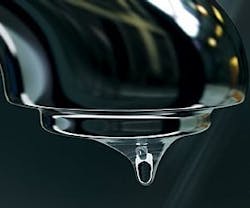Common Costly Plumbing Leaks
Plumbing leaks can come from a variety of sources. Hidden and visible leaks can easily waste thousands of gallons of water a year – not to mention the higher utility bills and the repair costs.
Toilet leaks are very common, but can be hard to diagnose. Leaks may occur from several sources. The most common tank toilet leak is the flapper or tank ball, which holds the water in the tank until the flush lever is activated.
The tank contains two valves: a flush valve and a refill valve. One type of refill valve is commonly called a ballcock. When the flush valve fails to seat properly, water is leaked from the tank into the bowl. The leaked tank water is replenished by the refill valve, causing a continuous flow of wasted water. A simple test for this leak is putting 8 to 10 drops of food coloring in the water tank. After 5 to 10 minutes, if you find food coloring in the water bowl, this indicates the possibility that the flapper/tank ball needs to be replaced. A good rule is to replace these parts every 2 years.
The second possible source of a tank toilet leak could be the fill valve or ballcock. This part turns on the water when the toilet is flushed and shuts off the water when the tank is refilled to its proper level. If this part fails and water doesn’t shut off, the tank will fill to overflow tube level, and all running water will go down the drain. In this situation, the fill valve needs to be replaced or rebuilt with new parts. Generally, it’s more cost effective to replace the fill valve. You should always use quality brand names. A flapper/tank ball will range from $4 to $7, and the fill valve/ballcock will range from $12 to $20. This will save money over the part’s lifetime in water saved.
Water fixtures that drip usually have worn-out parts and need to be repaired or replaced. Always remember to turn off the water and relieve the water pressure before attempting to disassemble the plumbing fixture.
Leaking faucets are manageable and can be repaired. Pressurized water is distributed to your property, and a faucet turns off by making a watertight seal strong enough to neutralize that pressure. A simple washer and seat assembly achieves this job; if your faucet is dripping, one of these two items probably needs to be replaced. You’ll first need to shut off the water and pull out the faucet. You’ll then see the washer. If replacing the washer doesn’t fix the leak, then the problem is probably in the brass seat, which is located behind the washer. You can fix it yourself if you have the proper seating wrench, but you can also call a professional plumber.
Although plumbing leaks can be costly if neglected, there are ways to prevent them by applying some simple prevention techniques. The most important part of avoiding huge plumbing-repair costs due to leaks is to take preventive measures and immediately address any leaks.
Dale Zager is the owner and founder of Zager Plumbing & Solar Inc., located in Deerfield Beach, FL.
